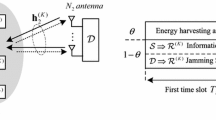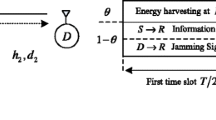Appendix 1: Proof of Proposition 1
The CDF of \(\gamma _e\) can be computed as
$$\begin{aligned} {F_{{\gamma _e}}}\left( y \right)&= \Pr \left( {\frac{{{\rho _s}{Y_1}}}{{{\rho _d}{Y_2} + 1}} < y} \right) \nonumber \\&= \int \limits _0^{ + \infty } {{F_{{Y_1}}}\left( {\frac{{y\left( {{\rho _d}{y_2} + 1} \right) }}{{{\rho _s}}}} \right) } {f_{{Y_2}}}\left( {{y_2}} \right) d{y_2}. \end{aligned}$$
(25)
The PDF of \(\gamma _e\) can be computed as
$$\begin{aligned} \frac{{d{F_{{\gamma _e}}}\left( y \right) }}{{dy}} = \frac{{{\rho _d}{y_2} + 1}}{{{\rho _s}}}\int \limits _0^{ + \infty } {{f_{{Y_1}}}\left( {\frac{{y\left( {{\rho _d}{y_2} + 1} \right) }}{{{\rho _s}}}} \right) } {f_{{Y_2}}}\left( {{y_2}} \right) d{y_2}. \end{aligned}$$
(26)
Using the PDF of \(Y_1\) given by (4) and PDF of \(Y_2\) given by (1), (26) can be expressed as
$$\begin{aligned} {f_{{\gamma _e}}}\left( y \right)&= \frac{{{\lambda _{{Y_1}}}{\lambda _{{y_2}}}}}{{{\rho _s}}}{e^{ - \frac{{k{\lambda _{{Y_1}}}}}{{{\rho _s}}}y}}\sum \limits _{k = 1}^K {k \left( {\begin{array}{c}K\\ k\end{array}}\right) {{\left( { - 1} \right) }^{k + 1}}} \nonumber \\&\quad \times \int \limits _0^{ + \infty } {\left( {{\rho _d}{y_2} + 1} \right) {e^{ - \left( {\frac{{k{\lambda _{{Y_1}}}{\rho _d}y}}{{{\rho _s}}} + {\lambda _{{y_2}}}} \right) {y_2}}}} d{y_2}. \end{aligned}$$
(27)
Using integration by parts, (27) can be rewritten as (10).
Appendix 2: Proof of Proposition 2
Using the PDF of \(X_2\) given by (1) and the CDF of \(X_1\) given by (2), (16) can be calculated as
$$\begin{aligned} {P_\text {sec,1}} = \int \limits _0^{{{{{\bar{x}}}}_1}} {{\lambda _{{X_2}}}{e^{ - {\lambda _{{X_2}}}{x_2}}}} d{x_2} + \int \limits _{{{{{\bar{x}}}}_1}}^{ + \infty } {\left( {1 - {e^{\frac{{{\lambda _{{X_1}}}\left( {\beta - 1} \right) }}{{\left( {1 - \theta } \right) {\rho _s}\varXi \left( {{X_2}} \right) }}}}} \right) } {\lambda _{{X_2}}}{e^{ - {\lambda _{{X_2}}}{x_2}}}d{x_2}. \end{aligned}$$
(28)
After some manipulations, \(P_\text {sec,1}\) can be expressed as in Proposition 2.
Appendix 3: Proof of Proposition 3
The expression in (18) can be rewritten as
$$\begin{aligned} {P_\text {sec,2}}&= \int \limits _{{{{{\bar{x}}}}_1}}^{ + \infty } {{f_{{{{X}}_2}}}\left( z \right) } \int \limits _{{\varXi _2}\left( {{X_2}} \right) }^{ + \infty } {{f_{{\gamma _e}}}\left( t \right) } \left( {F_{{X_1}}}\left( {\frac{{\beta t + \beta - 1}}{{\left( {1 - \theta } \right) {\rho _s}}}\left( {1 + \frac{\kappa }{z}} \right) } \right) \right. \nonumber \\&\quad \left. - {F_{{X_1}}}\left( {\frac{{\beta - 1}}{{\left( {1 - \theta } \right) {\rho _s}{\varXi _1}\left( z \right) }}} \right) \right) dyd{x_2} \nonumber \\&= \underbrace{\int \limits _{{{{{\bar{x}}}}_1}}^{ + \infty } {{f_{{X_2}}}\left( {{x_2}} \right) } {e^{ - \frac{{{\lambda _{{X_1}}}\left( {\beta - 1} \right) }}{{\left( {1 - \theta } \right) {\rho _s}{\varXi _1}\left( {{x_2}} \right) }}}}d{x_2}\int \limits _{{\varXi _2}\left( {{x_2}} \right) }^{ + \infty } {{f_{{\gamma _e}}}\left( y \right) } dy}_{{P_\text {sec,2,1}}} \nonumber \\&\quad - \underbrace{\int \limits _{{{{{\bar{x}}}}_1}}^{ + \infty } {{f_{{X_2}}}\left( {{x_2}} \right) } \int \limits _{{\varXi _2}\left( {{x_2}} \right) }^{ + \infty } {{f_{{\gamma _e}}}\left( y \right) } {e^{ - {\lambda _{{X_1}}}\frac{{\beta \left( {y + 1} \right) - 1}}{{\left( {1 - \theta } \right) {\rho _s}}}\left( {1 + \frac{\kappa }{{{x_2}}}} \right) }}dyd{x_2}}_{{P_\text {sec,2,2}}}. \end{aligned}$$
(29)
We focus on deriving the expression of \(P_\text {sec,2,2}\). Substituting the PDF of \(X_2\) given by (1) and the PDF of \(\gamma _e\) given by (10) in (29), and letting \(u = y - {\varXi _2}\left( {{x_2}} \right)\), \(P_\text {sec2,2}\) can be calculated as
$$\begin{aligned} {P_\text {sec,2,2}}&= {\lambda _{{X_2}}}\sum \limits _{k = 1}^K { \left( {\begin{array}{c}K\\ k\end{array}}\right) {{\left( { - 1} \right) }^{k + 1}}} \int \limits _{{{{{\bar{x}}}}_1}}^{ + \infty } {{e^{ - {\lambda _{{X_2}}}{x_2}}}} {e^{ - \frac{{{\lambda _{{X_1}}}}}{{\left( {1 - \theta } \right) {\rho _s}}}\left( {1 + \frac{\kappa }{{{x_2}}}} \right) \left( {\beta {\varXi _2}\left( {{x_2}} \right) + \beta - 1} \right) - \frac{{k{\lambda _{{Y_1}}}}}{{{\rho _s}}}{\varXi _2}\left( {{x_2}} \right) }} \nonumber \\&\quad \times \left( {\underbrace{\int \limits _0^{ + \infty } {\frac{{{\lambda _{{y_2}}}{e^{ - \left( {\frac{{k{\lambda _{{Y_1}}}}}{{{\rho _s}}} + \frac{{\beta {\lambda _{{X_1}}}}}{{\left( {1 - \theta } \right) {\rho _s}}}\left( {1 + \frac{\kappa }{{{x_2}}}} \right) } \right) u}}}}{{{\rho _d}\left( {u + {\varXi _2}\left( {{X_2}} \right) + {{{\beta _Y}} / k}} \right) }}} du}_{{I_1}} + \underbrace{\int \limits _0^{ + \infty } {\frac{{{\beta _Y}{e^{ - \left( {\frac{{k{\lambda _{{Y_1}}}}}{{{\rho _s}}} + \frac{{\beta {\lambda _{{X_1}}}}}{{\left( {1 - \theta } \right) {\rho _s}}}\left( {1 + \frac{\kappa }{{{x_2}}}} \right) } \right) u}}}}{{k{{\left( {u + {\varXi _2}\left( {{X_2}} \right) + {{{\beta _Y}}/ k}} \right) }^2}}}} du}_{{I_2}}} \right) d{x_2}. \end{aligned}$$
(30)
Solving \(I_1\) and \(I_2\) with the help of [12, Eq. (3.352.4) and Eq. (3.353.3)], \(P_\text {sec,2,2}\) can be calculated as
$$\begin{aligned} {P_\text {sec,2,2}}&= {P_{\sec ,2,1}} + \frac{{{\beta _Y}\beta {\lambda _{{X_1}}}{\lambda _{{X_2}}}}}{{\left( {1 - \theta } \right) {\rho _s}}}\sum \limits _{k = 1}^K {\left( {\begin{array}{c}K\\ k\end{array}}\right) \frac{{{{\left( { - 1} \right) }^{k + 1}}}}{k}} {e^{\frac{{{\lambda _{{Y_2}}}}}{{{\rho _d}}} + \frac{{{\lambda _{{X_1}}}}}{{\left( {1 - \theta } \right) {\rho _s}}}\left( {\frac{{\beta {\beta _Y}}}{k} - \beta + 1} \right) }} \nonumber \\&\quad \times \int \limits _{{{{{\bar{x}}}}_1}}^{ + \infty } {\left( {1 + \frac{\kappa }{{{x_2}}}} \right) } {e^{ - {\lambda _{{X_2}}}{x_2} + \frac{{{\lambda _{{X_1}}}\kappa }}{{\left( {1 - \theta } \right) {\rho _s}{x_2}}}\left( {\frac{{\beta {\beta _Y}}}{k} - \beta + 1} \right) }} \nonumber \\&\quad \times Ei\,\left( { - \frac{{{\varXi _2}\left( {{X_2}} \right) + {\textstyle {{{\beta _Y}} \over k}}}}{{{\rho _s}}}\left( {k{\lambda _{{Y_1}}} + \frac{{\beta {\lambda _{{X_1}}}}}{{\left( {1 - \theta } \right) }}\left( {1 + \frac{\kappa }{{{x_2}}}} \right) } \right) } \right) . \end{aligned}$$
(31)
By substituting (31) into (29), \(P_\text {sec,2}\) can be expressed as in (19).
Appendix 4: Proof of Proposition 5
Substituting the PDF of \(X_2\) given by (1), the PDF of \(\gamma _e\) given by (10), and the CDF of \(X_1\) given in (2), \(P_\text {sec,2}^\infty\) can be calculated as
$$\begin{aligned} P_{{\text {sec,2}}}^\infty&= \int \limits _{{{{{\bar{x}}}}_0}}^{ + \infty } {{\lambda _{{X_2}}}{e^{ - {\lambda _{{X_2}}}{x_2}}}} {e^{ - {\lambda _{{X_1}}}\frac{{\beta - 1}}{{\left( {1 - \theta } \right) {\rho _s}}}\left( {1 + \frac{\kappa }{{{x_2}}}} \right) }} \nonumber \\&\quad \times \left( {1 - \sum \limits _{k = 1}^K { \left( {\begin{array}{c}K\\ k\end{array}}\right) {{\left( { - 1} \right) }^{k + 1}}} \int \limits _0^{ + \infty } {\left( {\frac{{{\lambda _{{y_2}}}{e^{ - {{{{\mathcal {J}}}}}\left( {{x_2}} \right) y}}}}{{{\rho _d}\left( {y + {\textstyle {{{\beta _Y}} \over k}}} \right) }} + \frac{{{\beta _Y}{e^{ - {{{{\mathcal {J}}}}}\left( {{x_2}} \right) y}}}}{{k{{\left( {y + {\textstyle {{{\beta _Y}} \over k}}} \right) }^2}}}} \right) } dy} \right) d{x_2}, \end{aligned}$$
(32)
where \({{{{\mathcal {J}}}}}\left( {{x_2}} \right) = \frac{{\beta {\lambda _{{X_1}}}}}{{\left( {1 - \theta } \right) {\rho _s}}}\left( {1 + \frac{\kappa }{{{x_2}}}} \right) + \frac{{k{\lambda _{{Y_1}}}}}{{{\rho _s}}}\).
Solving the integrals in (32) with the help of [12, Eq. (3.352.4) and (3.353.3)], after some manipulations, \(P_\text {out,2}^\infty\) can be approximated as
$$\begin{aligned} P_{{\text {out,2}}}^\infty&= \frac{{{\beta _Y}\beta {\lambda _{{X_1}}}{\lambda _{{X_2}}}}}{{\left( {1 - \theta } \right) {\rho _s}}}\sum \limits _{k = 1}^K {\left( {\begin{array}{c}K\\ k\end{array}}\right) \frac{{{{\left( { - 1} \right) }^k}}}{k}} \nonumber \\&\quad \times \int \limits _{{{{{\bar{x}}}}_0}}^{ + \infty } {\left( {1 + \frac{\kappa }{{{x_2}}}} \right) {e^{ - {\lambda _{{X_2}}}{x_2}}}} Ei\left( { - {{{{\mathcal {J}}}}}\left( {{x_2}} \right) {\textstyle {{{\beta _Y}} \over k}}} \right) d{x_2}. \end{aligned}$$
(33)
Using [12, Eq.(8.214.1)], (33) can be approximated as
$$\begin{aligned} P_{{\text {out,2}}}^\infty&= \frac{{{\beta _Y}\beta {\lambda _{{X_1}}}{\lambda _{{X_2}}}}}{{\left( {1 - \theta } \right) {\rho _s}}}\sum \limits _{k = 1}^K { \left( {\begin{array}{c}K\\ k\end{array}}\right) \frac{{{{\left( { - 1} \right) }^k}}}{k}} \int \limits _{{{{{\bar{x}}}}_0}}^{ + \infty } {\left( {1 + \frac{\kappa }{{{x_2}}}} \right) {e^{ - {\lambda _{{X_2}}}{x_2}}}} \nonumber \\&\quad \times \ln \left( {\underbrace{\frac{{{\lambda _{{Y_2}}}}}{{{\rho _d}}}\left( {1 + \frac{{\beta {\lambda _{{X_1}}}}}{{k\left( {1 - \theta } \right) {\lambda _{{Y_1}}}}}} \right) }_{{I_1}} + \underbrace{\frac{{{\beta _Y}\beta {\lambda _{{X_1}}}\kappa }}{{k\left( {1 - \theta } \right) {\rho _s}}}}_{{I_2}}\frac{1}{{{x_2}}}} \right) d{x_2}. \end{aligned}$$
(34)
Using L’Hospital’s Rule, it is easy to show that \(I_2\) is dominant over \(I_1\), where \({x_2} \in \left[ {{x_0},M} \right)\) and \(M \ll + \infty\). Then, (34) can be rewritten as
$$\begin{aligned} P_{{\text {out,2}}}^\infty&= \frac{{{\beta _Y}\beta {\lambda _{{X_1}}}{\lambda _{{X_2}}}}}{{\left( {1 - \theta } \right) {\rho _s}}}\sum \limits _{k = 1}^K {\left( {\begin{array}{c}K\\ k\end{array}}\right) \frac{{{{\left( { - 1} \right) }^{k + 1}}}}{k}} \nonumber \\&\quad \times \underbrace{\int \limits _{{{{{\bar{x}}}}_0}}^{ + \infty } {\left( {1 + \frac{\kappa }{{{x_2}}}} \right) {e^{ - {\lambda _{{X_2}}}{x_2}}}} \ln \left( {{\rho _s}{x_2}} \right) d{x_2}}_{{I_3}}. \end{aligned}$$
(35)
With the help of [12, Eq. (4.337.1) and Eq. (3.351.5)], \(I_3\) is expressed as
$$\begin{aligned} {I_3}&= \frac{{{e^{ - {\lambda _{{X_2}}}{{{{\bar{x}}}}_0}}}\ln \left( {{\rho _2}{{{{\bar{x}}}}_0}} \right) }}{{{\lambda _{{X_2}}}}} - \left( {\kappa \ln \left( {{\rho _2}} \right) + \frac{1}{{{\lambda _{{X_2}}}}}} \right) Ei\left( { - {\lambda _{{X_2}}}{{{{\bar{x}}}}_0}} \right) \nonumber \\&\quad + \kappa \int \limits _{{{{{\bar{x}}}}_0}}^{ + \infty } {\frac{{\ln \left( {{x_2}} \right) }}{{{x_2}}}{e^{ - {\lambda _{{X_2}}}{x_2}}}} d{x_2}. \end{aligned}$$
(36)
With the help of Mathematica, Eq. (36) can rewritten as
$$\begin{aligned} {I_3}&= \frac{{{e^{ - {\lambda _{{X_2}}}{{{{\bar{x}}}}_0}}}\ln \left( {{\rho _2}{{{{\bar{x}}}}_0}} \right) }}{{{\lambda _{{X_2}}}}} - \left( {\kappa \ln \left( {{\rho _2}{{{{\bar{x}}}}_0}} \right) + \frac{1}{{{\lambda _{{X_2}}}}}} \right) Ei\left( { - {\lambda _{{X_2}}}{{{{\bar{x}}}}_0}} \right) \nonumber \\&\quad + \kappa G_{2,3}^{3,0}\left( {{\lambda _{{X_2}}}{{{{\bar{x}}}}_0}|_{0,0,0}^{1,1}} \right) . \end{aligned}$$
(37)









